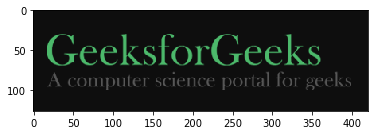Reading images in Python
Last Updated :
13 Feb, 2023
Python supports very powerful tools when comes to image processing. Let’s see how to process the images using different libraries like ImageIO, OpenCV, Matplotlib, PIL, etc.
- Using ImageIO : Imageio is a Python library that provides an easy interface to read and write a wide range of image data, including animated images, video, volumetric data, and scientific formats. It is cross-platform, runs on Python 3.7+, and is easy to install. It is the recommended alternative to scipy.misc.imread and is used internally by libraries like scikit-image to load images.
Python3
import imageio as iio
img = iio.imread("g4g.png")
iio.imwrite("g4g.jpg", img)
|
- Output:

- Using OpenCV : OpenCV (Open Source Computer Vision) is a computer vision library that contains various functions to perform operations on pictures or videos. It was originally developed by Intel but was later maintained by Willow Garage and is now maintained by Itseez. This library is cross-platform that is it is available on multiple programming languages such as Python, C++ etc.
Python3
import cv2
img = cv2.imread('g4g.png')
cv2.imshow('image', img)
cv2.waitKey(0)
cv2.destroyAllWindows()
|
- Output :

-
- Using MatplotLib : Matplotlib is an amazing visualization library in Python for 2D plots of arrays. Matplotlib is a multi-platform data visualization library built on NumPy arrays and designed to work with the broader SciPy stack. It was introduced by John Hunter in the year 2002. Matplotlib comes with a wide variety of plots. Plots helps to understand trends, patterns, and to make correlations. They’re typically instruments for reasoning about quantitative information.
Python
import matplotlib.image as mpimg
import matplotlib.pyplot as plt
img = mpimg.imread('g4g.png')
plt.imshow(img)
|
- Output :

-
- Using PIL : PIL is the Python Imaging Library which provides the python interpreter with image editing capabilities. It was developed by Fredrik Lundh and several other contributors. Pillow is the friendly PIL fork and an easy to use library developed by Alex Clark and other contributors.
Python
from PIL import Image
img = Image.open('g4g.png')
img.show()
print(img.format)
print(img.mode)
|
- Output :

PNG
RGBA
Like Article
Suggest improvement
Share your thoughts in the comments
Please Login to comment...